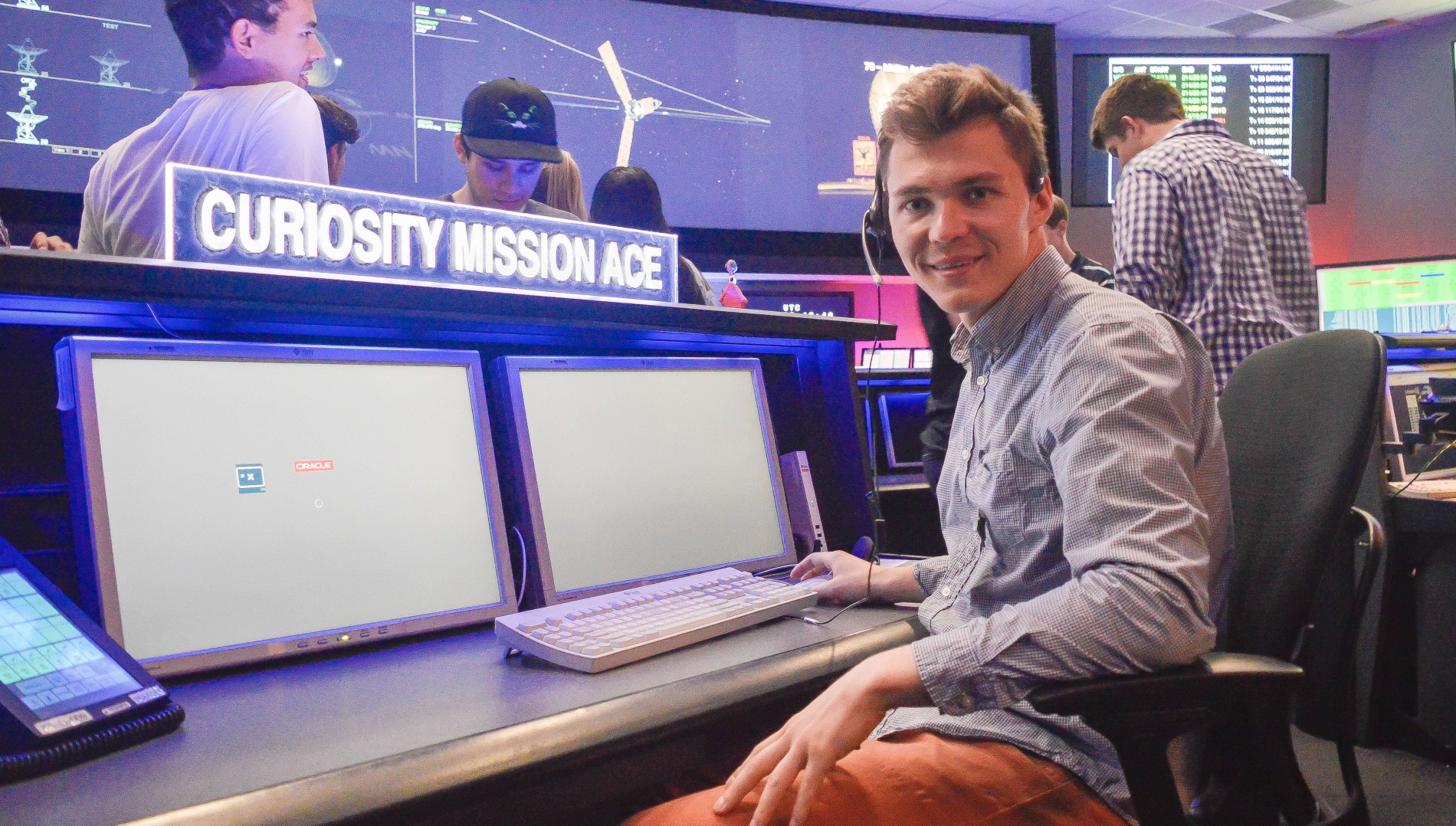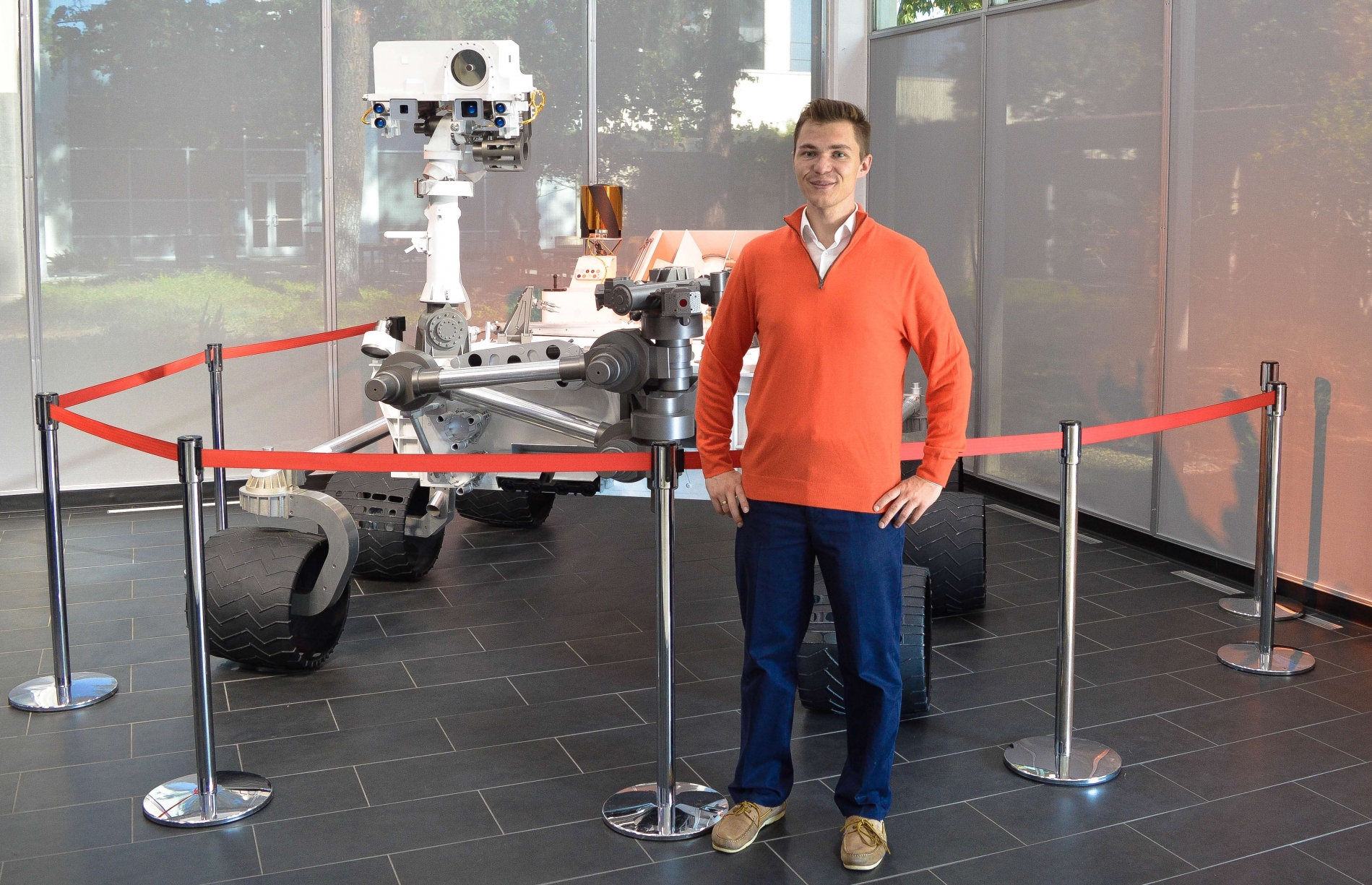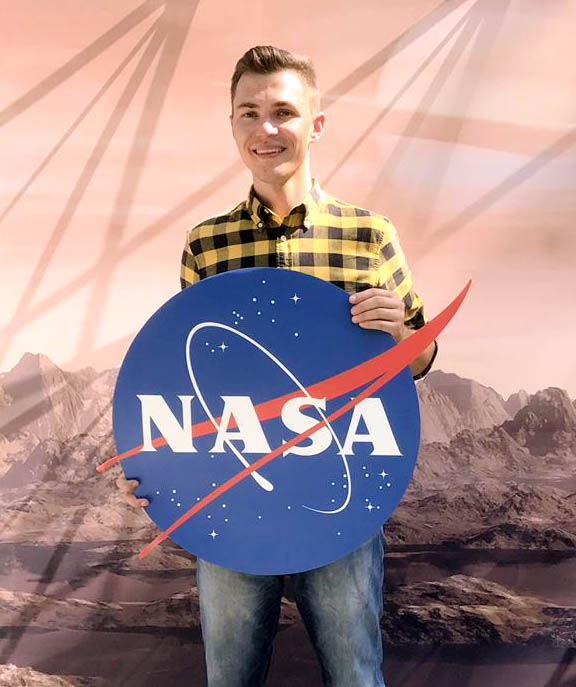YOUR BROWSER IS OUT-OF-DATE.
We have detected that you are using an outdated browser. Our service may not work properly for you. We recommend upgrading or switching to another browser.
Date: 13.01.2020 Category: general news, international cooperation, science/research/innovation
Łukasz Sterczewski, PhD, Eng of the Faculty of Electronics is on a two years’ placement at the NASA ‘s Jet Propulsion Laboratory. When working on ultra-accurate lasers and meeting candidates for astronauts and designers of rovers and satellites, he is exploring the space industry from a completely new perspective.
 Jet Propulsion Laboratory is one of the research centres of the American space agency, located in Pasadena, California. As the command centre for NASA's space trials outside the Earth's attraction zone, the facility is responsible for activities such as managing unmanned space flights.
Jet Propulsion Laboratory is one of the research centres of the American space agency, located in Pasadena, California. As the command centre for NASA's space trials outside the Earth's attraction zone, the facility is responsible for activities such as managing unmanned space flights.
Łukasz Sterczewski, PhD, Eng obtained his engineering degree at WUST’s Faculty of Electronics and completed his MSc programme with distinction on the specialisation course "Advanced Applied Electronics", delivered in English. In 2018, he received a doctorate of technical sciences in the field of telecommunications for the awarded thesis entitled "Signal Processing in Terahertz and Mid-infrared Spectroscopy with Frequency Combs", supervised by Professor Edward Pliński from WUST, and co-supervised by Professor Gerard Wysocki from Princeton University.
He is the winner of grants and scholarships including the Kościuszko Foundation's grant for scientific research conducted in the USA in 2017, the Scholarship of the Minister of Science and Higher Education for outstanding achievements in the academic year 2017/2018, and the START scholarship awarded by the Foundation for Polish Science to the most talented young scientists in 2018.

In his scientific work, he deals with laser spectroscopy, a technique where a laser is used to examine the interaction of light with matter. This, in turn, makes it possible to estimate the chemical composition of the sample under examination, even remotely - it is enough for the laser light to pass through the object and return to it.
In practice, this technique allows for quick and precise examination of the composition of the atmosphere and the traces of various gases and compounds present in it, both on Earth and on distant planets, where spectroscopic instruments can be sent aboard space probes. Due to the precision of the measurement, miniaturisation, and the laser’s long life cycle, this technique can be used in military applications where rapid atmospheric measurement for the presence of certain substances is often crucial. It can also be used in the petrochemical, pharmacological, marine, and air transport industries.
Dr Sterczewski's American adventure began in late spring 2015 at Wrocław University of Science and Technology. As a first-year doctoral student, he participated in lectures delivered by Professor Gerard Wysocki from Princeton University, who was staying at our university under the Visiting Professors programme.
- I was then impressed by the innovative character of the research conducted by Professor Wysocki at Princeton and its convergence with my interests. After the first lecture, I stayed in the room and presented my research and spectroscopic experiments to him. After a longer while, Professor Wysocki asked me an unexpected question: “Would you like to go to America?". I answered yes without hesitation, although it then turned my life upside down - admits Dr Sterczewski.
He joined Professor Wysocki’s team already in autumn 2015 and spent 2.5 years in the USA. During this time, he worked on highly miniaturised cascade lasers emitting light in the medium and far-infrared ranges, their use for detecting trace amounts of gases of high environmental importance, as well as imaging pharmaceutical samples.
During his stay in Princeton, an opportunity to work at NASA's Jet Propulsion Laboratory suddenly arose before the then PhD student. At one of the scientific conferences, Professor Wysocki initiated the cooperation with researchers of JPL’s Microdevices Laboratory. As a result, the Princeton laboratory received lasers similar to those used during the Curiosity mission to detect methane on Mars.
- Of course, we’re talking about inter-band cascade lasers (ICL’s). I was very excited about it and I quickly designed the appropriate instruments for their characterisation. Thanks to it, we discovered many interesting phenomena occurring in the cavities of these miniature laser radiation sources, and the results obtained turned out to be of interest to our scientific partners. After half a year, they invited me to apply for the JPL Graduate Fellowship programme, which offers the "taste" of space technology research to people from almost all over the world. I did well and joined the laboratory as a holiday placement participant in the summer of 2017 - says Dr Sterczewski.
After completing the placement, he decided to return to the USA after defending his doctorate, but this time it was another contest and the stay was longer. The opportunity to do so presented itself in the shape of a special programme managed by Universities Space Research Association, called "NASA Postdoctoral Program".
The decision to grant our Dr Sterczewski a postdoctoral placement in NASA’s Jet Propulsion Laboratory was made in October 2018, allowing our researcher to start preparing for the trip.
 The postdoctoral placement at NASA is scheduled for two years, and the participant receives a monthly allowance and a health insurance subsidy. You also have a budget for conference and business trips. However, you have to take care of the accommodation yourself, as the Caltech (California Institute of Technology) dormitories are available mainly for PhD students and students. Most placement participants, therefore, have to look for accommodation within a longer distance of the lab and get there on their own.
The postdoctoral placement at NASA is scheduled for two years, and the participant receives a monthly allowance and a health insurance subsidy. You also have a budget for conference and business trips. However, you have to take care of the accommodation yourself, as the Caltech (California Institute of Technology) dormitories are available mainly for PhD students and students. Most placement participants, therefore, have to look for accommodation within a longer distance of the lab and get there on their own.
- During the placement, I’m doing research on the use of optical frequency combs based on inter-band cascade lasers to detect traces of gaseous organic molecules. In other words, I'm investigating the possibility of using these sources in a spectrometer similar to the one that’s already on Mars. However, this time, instead of studying only a narrow part of the optical spectrum, I'd like to take measurements on almost a hundred wavelengths at the same time. This unique structure of the light source, where instead of a single line we have equally distant teeth of the frequency comb, allows for measurements of unprecedented frequency precision as well as the examination of chemical transformations of a high time dynamics. It’s ideal for gas mixtures where information from multiple absorption lines at the same time enables a more accurate estimation of the percentage composition of the mixture - explains the scientist.
The previous stay at Princeton and the summer placement at NASA allowed our scientist to become acquainted with the rules of this type of facilities, but only the longer stay gave him an opportunity to learn about the curiosities associated with working at a space agency.
- For example, California is an area with increased seismic activity, and earthquakes are a serious threat here - for many years there has been talk of an impending cataclysm. That's why JPL periodically simulates such an event in order to develop natural reflexes in employees related to ways to behave in such a situation. You can hear the sounds of earthquakes and car alarms from the loudspeakers installed in the building, and the staff must hide under desks and wait until the simulated event is over. There are also special procedures for securing valuable equipment for space missions in case of such events - says the scientist.
What he experiences almost every day, and for which he is most grateful, is the ease with which he can make contact and talk constructively and without barriers with high profile experts - top-class specialists in their fields, who he has the opportunity to meet every day in different circumstances on the campus or at the local canteen.
- This gives you the opportunity to have an interesting exchange of views and ideas on various engineering and scientific issues. It was also a big surprise for me that the employees can at any time enter the building where the space rover for the Mars 2020 mission is being tested. It’s a perfect recipe for moments of weaker motivation: 20 metres away from where I am, there’s a vehicle that will be negotiating the surface of another planet in a moment - he stresses.
Bearing in mind what has been said, would he like to stay in the USA? The United States is a country of great opportunities, which after a longer stay will certainly open up even more. Nevertheless, I’m still in tough with Wrocław University of Science and Technology and I’m looking for opportunities to continue my scientific work in my home town - he admits.
And what advice would he give to students and young scientists who would like to go on a placement abroad, but for various reasons are still hesitating? - It’s natural to have doubts. - My advice is to first try to leave for a shorter time - a few months up to a year. Foreign placements broaden your horizons, enrich your professional portfolio, and help you gain valuable contacts. To paraphrase Einstein's words, you can't expect different results while still doing the same thing. A placement always changes something in you and often helps you discover new professional or scientific interests that can result in better work - emphasises Dr Łukasz Sterczewski.
Our site uses cookies. By continuing to browse the site you agree to our use of cookies in accordance with current browser settings. You can change at any time.